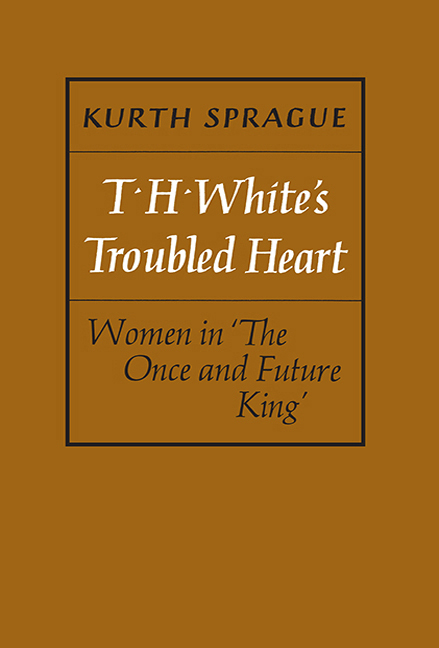Book contents
- Frontmatter
- Dedication
- Contents
- Miscellaneous Frontmatter
- Acknowledgements
- Foreword T. H. White Holdings at the Harry Ransom Center
- Preface
- Introduction
- Chapter One T.H. White
- Chapter Two Constance White
- Chapter Three White's Sources
- Chapter Four Omitted and Minor Characters
- Chapter Five Morgause
- Chapter Six Guenever
- Conclusion
- Appendixes
- Notes
- Survey of Criticism on White
- Bibliography
- Frontmatter
- Dedication
- Contents
- Miscellaneous Frontmatter
- Acknowledgements
- Foreword T. H. White Holdings at the Harry Ransom Center
- Preface
- Introduction
- Chapter One T.H. White
- Chapter Two Constance White
- Chapter Three White's Sources
- Chapter Four Omitted and Minor Characters
- Chapter Five Morgause
- Chapter Six Guenever
- Conclusion
- Appendixes
- Notes
- Survey of Criticism on White
- Bibliography
Summary
The story of Morgause is also the story of White's struggles with Queen. Her depiction cost White a great deal of effort and worry as he revised numerous times the book in which she first appears. His correspondence with Garnett and others as well as his journal entries attest to the difficulty under which he labored as he attempted to exorcise the presence of his mother in the witch. She dominates Queen, the book that Witch became, and so I shall first examine the history of this book and her presence in it before considering her return in the final book of TOAFK, Candle.
The original version of Queen, Witch, was begun apparently in late 1938. Fishing in Ireland in February 1939 with his friend David Garnett, White decided to stay on after Garnett left:
The Boyne must be full of [fish], since it had yielded one in the first quarter of an hour; and in the intervals of fishing he would finish The Witch in the Wood. He supposed it would be a matter of a fortnight or so.
On 5 May 1939, in a letter to Sir Sydney Cockerell, White mentioned that he had finished the manuscript, and he took it across to England around 20 May 1939. The indications are therefore that the last part of Witch and whatever reviewing and rewriting White felt necessary were accomplished in Ireland, where White lived from February 1939 to September 1945, during a time when a good bit of his energies might be expected to be used up in outdoor pursuits. The first hint that White felt uneasy about his production came in a letter to Garnett dated 29 May 1939: ‘I have finished my book called The Witch in the Wood and left it to be typed in England. It may not be any good.’
White's reservations concerning Witch were not misplaced: Collins wrote to say that the manuscript of Witch did not meet their standards for publication. Warner, noting that White at about this time lost two of his hawks because he did not take enough time with their early training, quotes from one of White's diaries and makes the point that something of the same kind had occurred with Witch:
‘Falconry is like treason—it is all plotting.’
- Type
- Chapter
- Information
- T. H. White's Troubled HeartWomen in <I>The Once and Future King</I>, pp. 95 - 116Publisher: Boydell & BrewerPrint publication year: 2007

